Introduction
Specimen Studies
0.1.1 | 0.1.2 | 0.1.3 | 0.1.4 | 0.1.5Methods
0.2.1 | 0.2.2The Structure of this Dissertation
0.3.1Tuberculosis' Visual Culture
Visual Practices in Medical Culture
1.1.1 | 1.1.2 | 1.1.3Seeing and Settling in the Sanatorium Movement
1.2.1 | 1.2.2 | 1.2.3 | 1.2.4 | 1.2.5Teaching Public Health
1.3.1 | 1.3.2 | 1.3.3 | 1.3.4 | 1.3.5Representing Doctors in Tuberculous Contexts
1.4.1 | 1.4.2Using Human Specimens in the Study of Tuberculosis
Seeing Disease in Methyl Violet
2.1.1 | 2.1.2 | 2.1.3 | 2.1.4Case Histories
2.2.1 | 2.2.2 | 2.2.3 | 2.2.4Visceral Processes
2.3.1 | 2.3.2Relation
2.4.1 | 2.4.2 | 2.4.3Arts-Based Inquiry
Introduction
3.1.1 | 3.1.2 | 3.1.3 | 3.1.4Terminal Imaginaries & Tuberculous Imaginaries
3.2.1 | 3.2.2 | 3.2.3 | 3.2.4 | 3.2.5 | 3.2.6Dermographic Opacities
3.3.1 | 3.3.2 | 3.3.3 | 3.3.4Tactical Pretensions
3.4.1 | 3.4.2 | 3.4.3Designing Opacity
A Shift towards the Anticolonial
4.1.1 | 4.1.2 | 4.1.3 | 4.1.4Refusals and Opacities
4.2.1 | 4.2.2 | 4.2.3 | 4.2.4Digital and Ethical Workflows
4.3.1 | 4.3.2 | 4.3.3 | 4.3.4 | 4.3.5Conclusion
4.4.1Coda
Prometheus Undone
5.1.1 | 5.1.2 | 5.1.3 | 5.1.4Appendix
The Tuberculosis Corpus
X.1.1 | X.1.2 | X.1.3Web Design
X.2.1 | X.2.2 | X.2.3 | X.2.4Installation Materials
X.3.1 | X.3.2 | X.3.3Index
Between the completion of Terminal Imaginaries (3.2.1) and its follow up installation, Tuberculous Imaginaries (3.2.4), I developed a photo essay for the digital humanities methods journal Epoiesen. I will not go into much detail as to the written content, because it is openly accessible online;1 instead, I want to address two aesthetic aspects of the project: 1) the modes of opacity employed in the essay and 2) how the project took advantage of web-based publishing for its aesthetic and academic argument. I will finish this section with a description of how the iterative and recursive engagement with arts-based research can go hand in hand with more traditional modes of written scholarship.
I have referenced the idea of opacity earlier in this chapter, and I will describe the concept more fully in the next (4.1.4; 4.2.3; 4.2.5), but it is difficult to describe “Dermographic Opacities” without touching on the concept. Opacity comes from the postcolonial philosophy of Édouard Glissant, and it is an anti-essentialist approach to knowledge production. Opacity contradicts the western academic obsession with totality and transparency.2 This philosophical concept is premised on the idea that some things cannot and should not be known, and that subjects have a right to refuse their inclusion within a knowledge system.
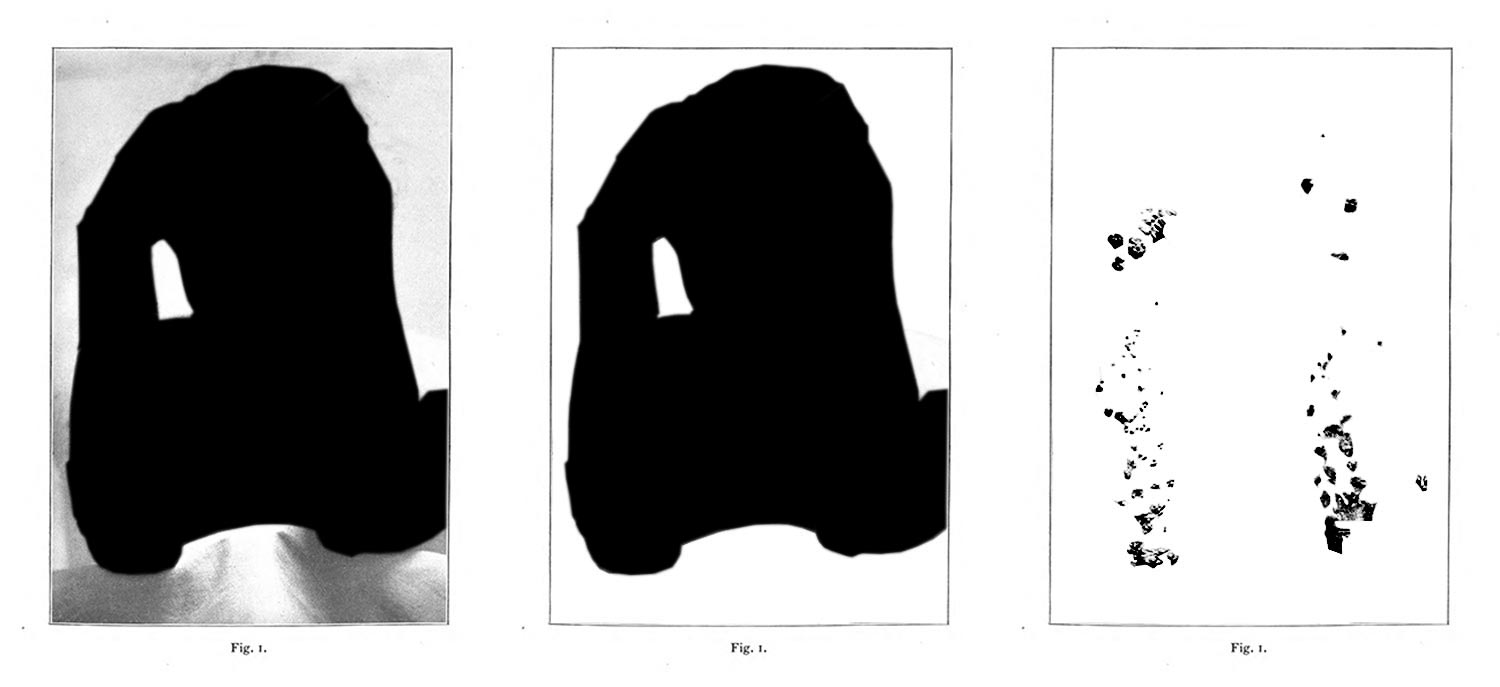
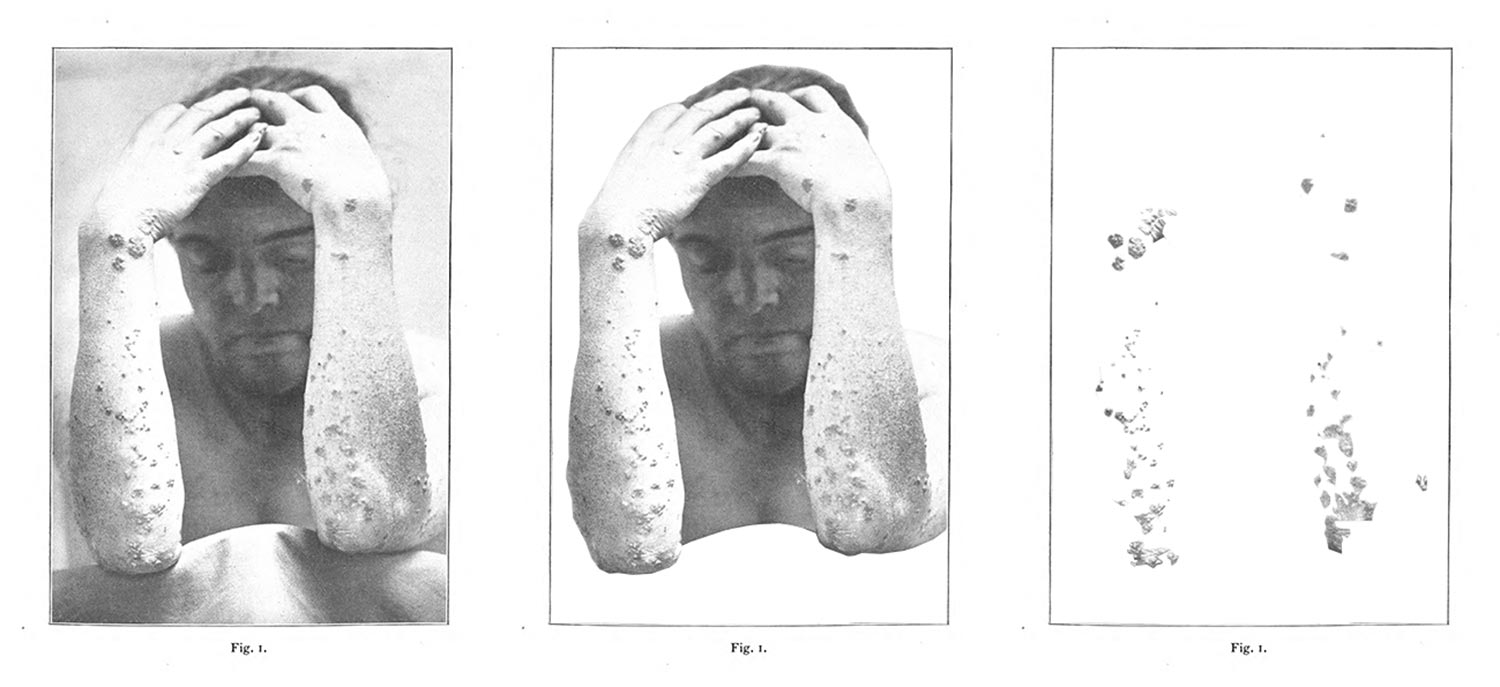
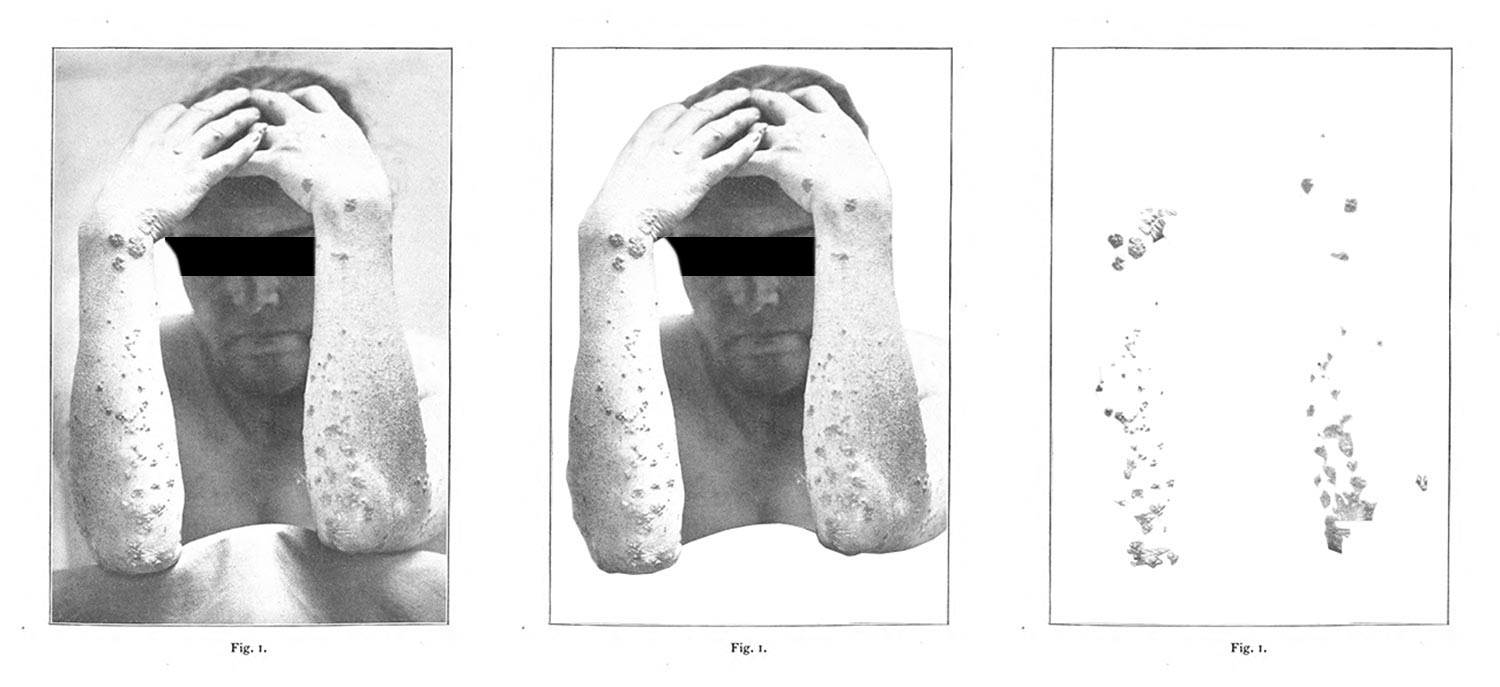
Opacity functioned differently in “Dermographic Opacities” than it does in this dissertation. In the essay’s conclusion, I wrote,
I made a call for an ethic of opacity: to offer these subjects a way of being viewed that does not reduce them to a disciplinary object. In the essay I failed (intentionally) because the physiognomy of the subjects forwarded my own claims concerning the racial, classed character of medical research (see Washington, 2006; Owens, 2017). My method sought to amplify frictions I saw in the material, and thus relied on the exploitative image itself to establish my claims—I reified the significance of these horrible images at the same time it tried to reject them.3
Opacity became a method to enact a further revealing, albeit one which peeled back the intention implicit in medicine’s visual practices. For this project, opacity produced a result that could be analyzed. I applied opacity to a number of images which were primarily taken from sources consulted in the Terminal Imaginaries installation, looking specifically at the dermatological textbooks sampled for projector A (4.2.1). The project revised these images with different modes of excision, cutting away the material in the image until only the disease remained (figs. 1 & 2).
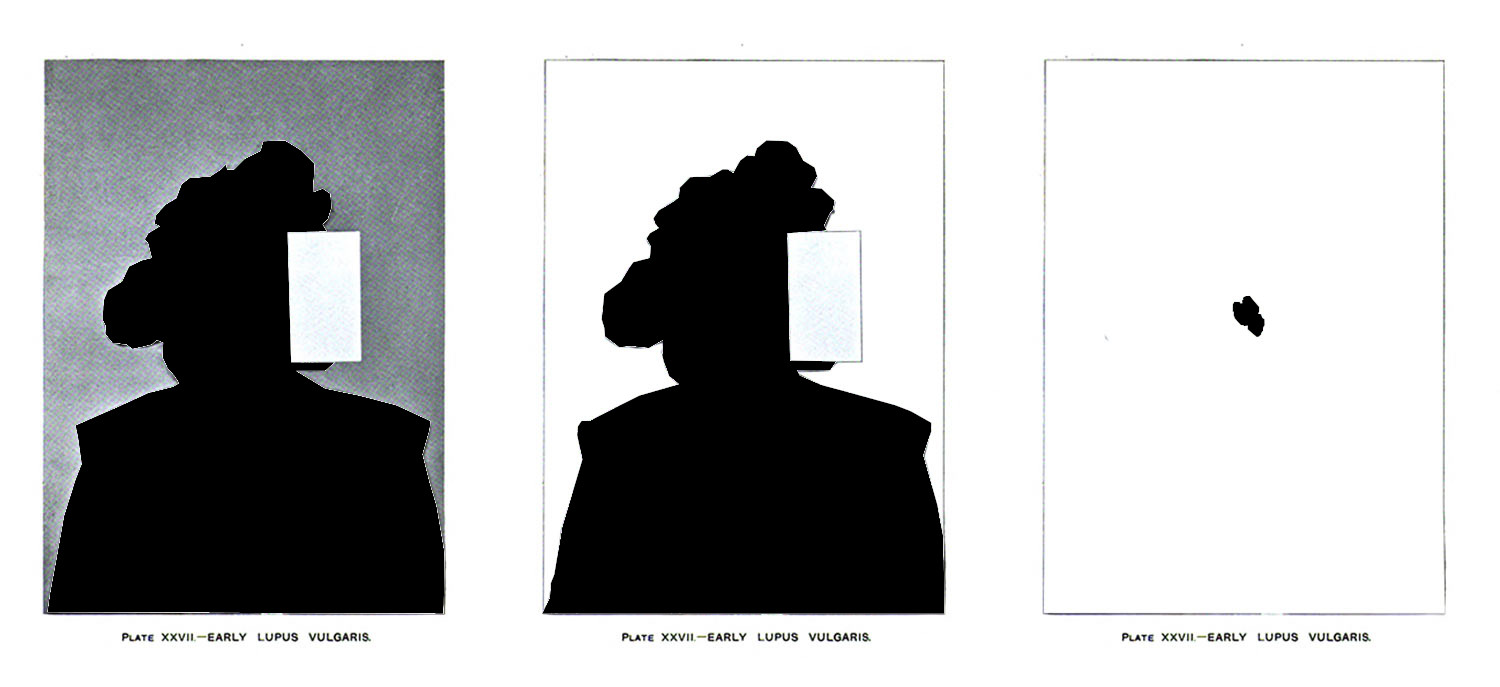
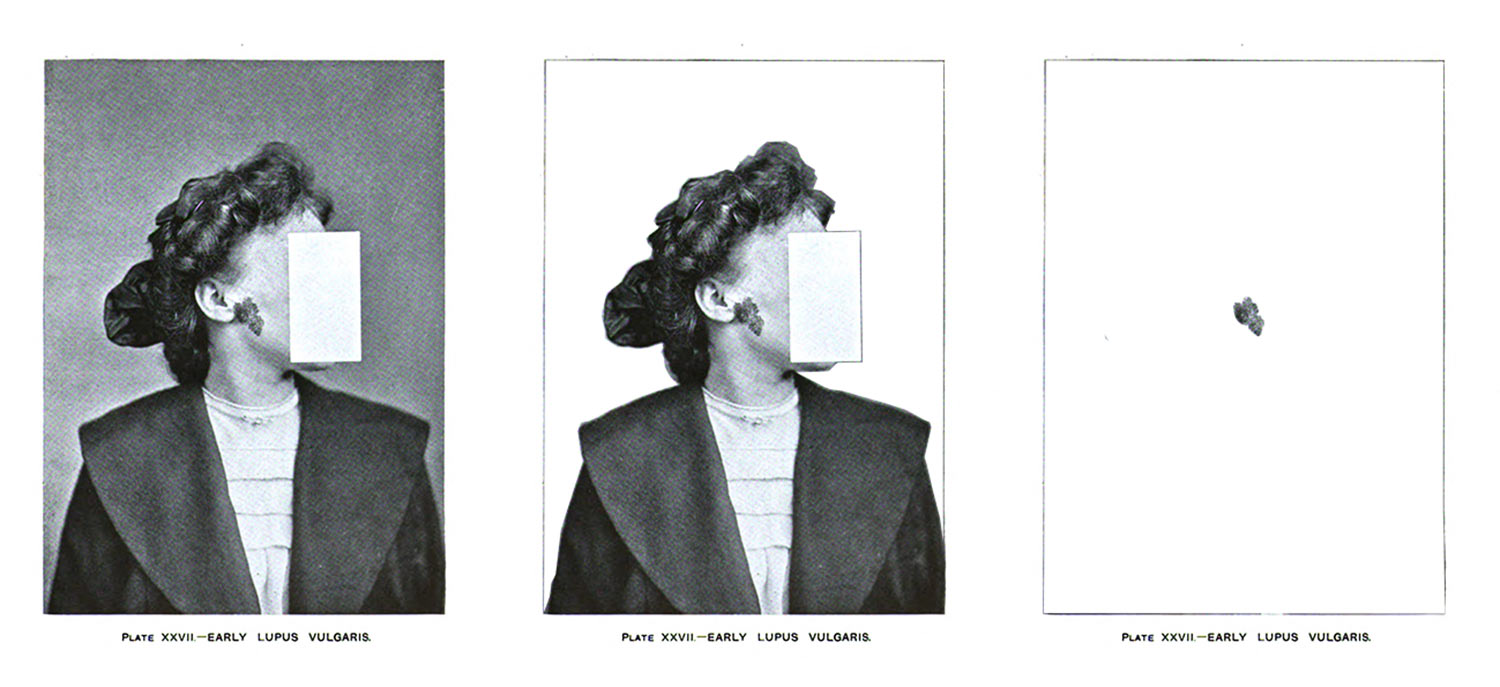
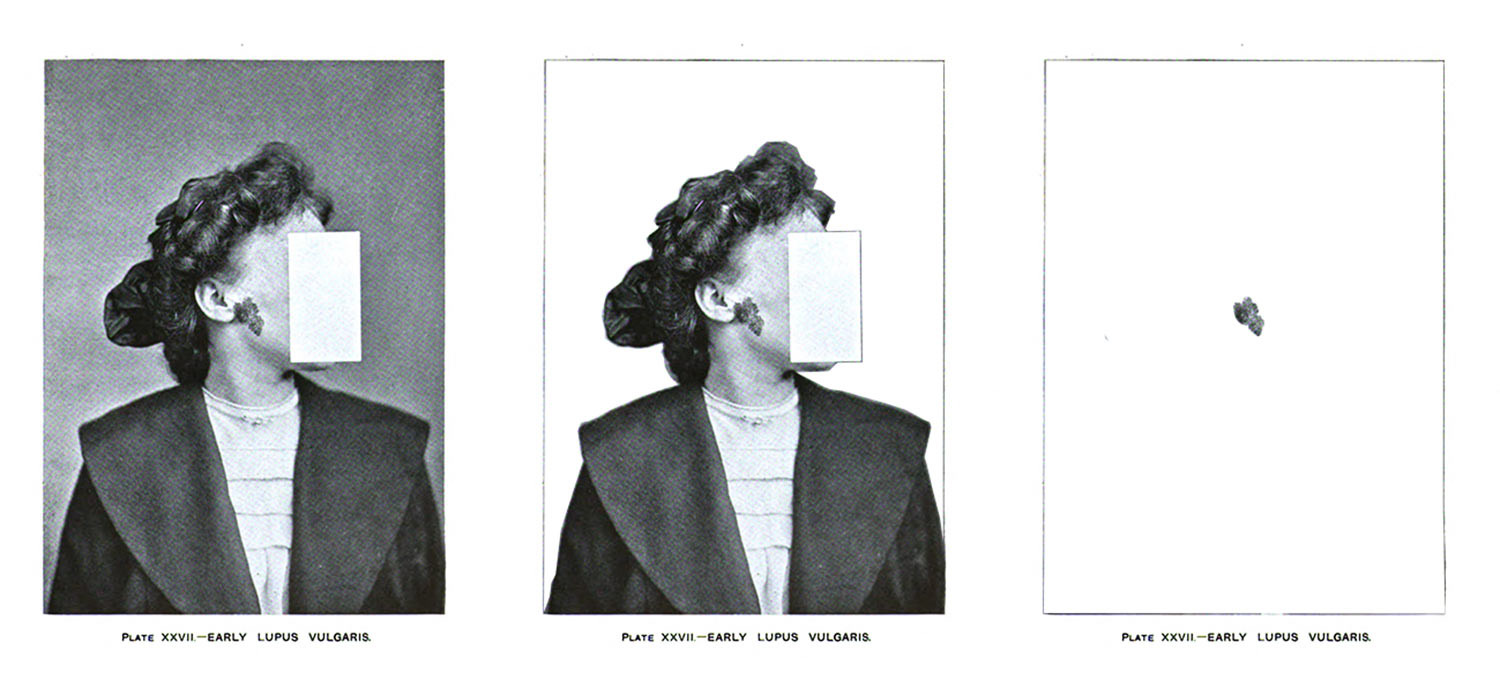
The choice to cut away at the image, to frame through erasure, through an activation of the opaque was decided by two criteria. The first moment of erasure was intended to frame the interventions by medical professionals. The hands that grab the head of a patient (fig. 1), or the mechanical apparatuses that hold a patient in place (1.4.2). The second layer of erasure was applied to display clinical photography’s assumed desire: the actual embodied symptoms found on the bodies of the sitter. The photo essay’s readers could flip through the images with the use of a little bit of simple CSS (Cascading Style Sheets) incorporated into the page’s HTML (Hypertext Markup Language). The next two sections (4.3.2, 4.3.3) will describe the process in each format, briefly.
-
Purcell, Sean. “Dermographic Opacities.” Epoiesen, 2022. http://dx.doi.org/10.22215/epoiesen/2022.1. ↩
-
This obsession with transparency is also quite literal in terms of medical epistemics.
Dijck, José van. The Transparent Body: A Cultural Analysis of Medical Imaging. Seattle & London: University of Washington Press, 2005. ↩
-
Purcell, Sean. “Dermographic Opacities.” Epoiesen, 2022. http://dx.doi.org/10.22215/epoiesen/2022.1.
I cite:
Owens, Deirdre Cooper. Race, Gender, and the Origins of American Gynecology. Athens: The University of Georgia Press, 2017; and Washington, Harriet A. Medical Apartheid: The Dark History of Medical Experimentation on Black Americans from Colonial Times to the Present. New York: Harlem Moon & Broadway Books, 2006. ↩
